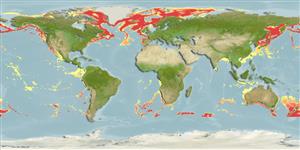Пластиножаберные (акулы и скаты) (sharks and rays) >
Rajiformes (Skates and rays) >
Rajidae (Skates)
Etymology: Amblyraja: Greek, amblys = darkness + Latin, raja, -ae = ray (Raja sp.) (Ref. 45335).
Environment: milieu / climate zone / пределы глубины / distribution range
экология
морской батидемерсальный; пределы глубины 92 - 2925 m (Ref. 119696), usually 300 - 2300 m (Ref. 9261). Deep-water; -1°C - 4°C (Ref. 119696); 82°N - 50°S, 180°W - 180°E
Arctic, Indian, Pacific and Atlantic oceans: in cold and deep waters.
Length at first maturity / Size / Вес / Возраст
половая зрелость: Lm ?, range 94 - ? cm
Max length : 112 cm TL самец/пол неопределен; (Ref. 114953); 100.0 cm TL (female)
Краткое описание
определительные ключи | морфология | морфометрия
Grey-brown with large dark blotches (Ref. 26346). Tail very short (Ref. 26346). Mid-dorsal row of stout thorns which extend from nuchal region to first dorsal fin. Thorns close posterior to the pelvic girdle larger than along the tail (Ref. 6902). Upper surface dark mouse gray, dark blue gray or dark brown with small rounded spots. Lower surface white and sooty in variable patterns (Ref. 6902).
Body shape (shape guide): other.
Found on the lower continental slope (Ref. 6871), probably most common on deep slopes and at abyssal depths (Ref. 114953). Benthic (Ref. 58426); meso- to bathybenthic, on muddy substrate (Ref. 119696). Adults feed on all kinds of bottom animals (Ref. 3167). Prefer polar temperatures from hatching to maturity and eggs are incubated successfully and regularly in water as cold as 0°C (Ref. 6902). Oviparous. Distinct pairing with embrace. Young may tend to follow large objects, such as their mother (Ref. 205). Eggs are oblong capsules with stiff pointed horns at the corners deposited in sandy or muddy flats (Ref. 205). Egg capsule measures 81-125 mm long and 50-80 mm wide (Ref. 41251). Hatching size at 16-18 cm TL (Ref. 114953) (15 cm long in Ref. 119696).
Life cycle and mating behavior
половая зрелость | размножение | нерест | икра | Fecundity | личинки
Oviparous, paired eggs are laid. Embryos feed solely on yolk (Ref. 50449). Distinct pairing with embrace. Young may tend to follow large objects, such as their mother (Ref. 205).
McEachran, J.D. and K.A. Dunn, 1998. Phylogenetic analysis of skates, a morphologically conservative clade of elasmobranchs (Chondrichthyes: Rajidae). Copeia 1998(2):271-290. (Ref. 27314)
Статус Красного Списка МСОП (Ref. 130435: Version 2025-1)
Угроза для людей
Harmless
Использование человеком
рыболовство: интереса не представляет
дополнительная информация
инструменты
Специальные отчеты
Скачать в формате XML
ресурсы в Интернет
Estimates based on models
Preferred temperature (ссылка
123201): 0.3 - 8.8, mean 3.3 °C (based on 3242 cells).
Phylogenetic diversity index (ссылка
82804): PD
50 = 0.5039 [Uniqueness, from 0.5 = low to 2.0 = high].
Bayesian length-weight: a=0.00302 (0.00141 - 0.00645), b=3.24 (3.07 - 3.41), in cm total length, based on LWR estimates for this (Sub)family-body shape (Ref.
93245).
Trophic level (ссылка
69278): 4.3 ±0.5 se; based on diet studies.
устойчивость к внешним воздействиям (ссылка
120179): низкий, минимальное время удвоения популяции 4.5-14 лет (Fec assumed to be <100).
Fishing Vulnerability (Ref.
59153): High to very high vulnerability (67 of 100).
🛈
Climate Vulnerability (Ref.
125649): Moderate vulnerability (38 of 100).
🛈
Nutrients (Ref.
124155): Calcium = 3.31 [0.50, 67.94] mg/100g; Iron = 0.302 [0.029, 4.121] mg/100g; Protein = 15.3 [13.3, 17.3] %; Omega3 = 0.494 [0.199, 1.207] g/100g; Selenium = 20.6 [3.6, 97.8] μg/100g; VitaminA = 6.37 [0.45, 85.10] μg/100g; Zinc = 0.206 [0.013, 2.410] mg/100g (wet weight);
